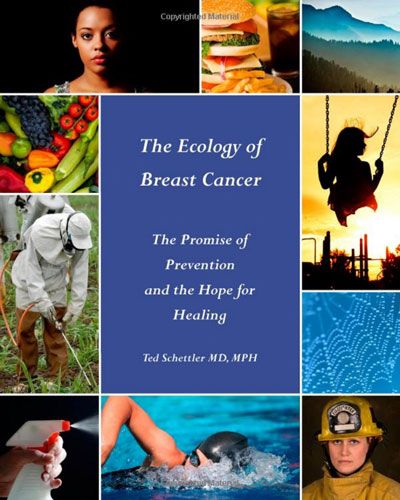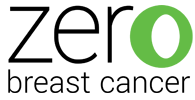
Overview
Dr. Schettler introduces the Ecological model, a model of complex and interrelated systems, as a framework to understand breast cancer risk and health interventions to reduce risk. The book gives an in depth overview of the latest scientific research on known risk factors for breast cancer. The author points out that while some evidence on breast cancer risk is strong, the body of evidence varies widely, results are often conflicting and studies are fraught with limitations. There are many uncertainties and unknowns when it comes to understanding the scientific complexity of this disease. How do we sift through the intricacies of the data to know what actions to take for reducing risk in our lives? How can we move forward with the best evidence available to create healthier communities for ourselves, our families and for society? Dr. Schettler’s book addresses these timely and critical questions.
How the book is organized
The book begins with an introduction and is organized into three sections. Section I gives background on the history of breast cancer and introduces the ecological model. Section II is divided into five chapters that outline the evidence on specific risk factors (diet/nutrition, physical activity, environmental chemicals and contaminants, electromagnetic energy and stress). Section III provides a summary of evidence on modifiable risk factors and gives strategies for healthy living.
Introduction
Dr. Schettler introduces the Ecological model as a tool for understanding the multi-layered context of the disease. Historically, epidemiologic research has focused on single variable study design and followed a reductionist, scientific approach. While extremely necessary and valuable, he acknowledges the limitations of individual level research and the challenges with translating research outcomes to population level interventions. He presents the eco-social model as a framework for understanding an inter-relational and dynamic environment of disease. He states, “Breast cancer fits well into this framework. Many, multi-level environmental factors interact with human breast biology, beginning with early development and continuing throughout life. Breast cancer is an ecological disease as much as it is a disease of abnormal cellular growth.”
Section I
In Chapter 1, the author introduces a systems approach for understanding the disease. A systems approach involves incorporating interactions and relationships between multiple variables in our environment. The author presents the concept of milieu intérieur, or internal physiologic environment, and how it affects biological mechanisms of disease on the cellular level. The physiologic environment is influenced by lifestyle and environmental factors (physical activity, nutrition, dietary patterns, sleep, exposure to chemicals in the environment and stress) in ways that we are only beginning to uncover through epidemiological research. Chapter 2 identifies trends of breast cancer incidence and risk factors (personal and family history, genetics, breast density, late age at first pregnancy, having no children, early puberty, late age of menopause, chest radiation, recent oral contraceptive use, combination hormone therapy, cigarette smoking and others).
Section II
This section is divided into five chapters that evaluate the literature on specific risk factors. Each chapter begins with an organized summary of evidence and continues with more detailed topics of research.
Chapter 3
- Covers dietary fat, meat consumption, soy and breast cancer risk and exposes some limitations with nutrition intervention studies.
Chapter 4
- Presents well-charted summaries on some of the most promising evidence on risk reduction through physical activity for both pre-and post-diagnosis groups. It discusses how biologic mechanisms may play a role in reducing risk through exercise.
Chapter 5
- Focuses on environmental chemicals and contaminants. One main study of interest is The Institute of Medicine’s 2012 report on chemically related increases in risk from combination hormone therapy, oral contraceptives, alcohol consumption and tobacco smoking.
- The chapter also covers recent information on endocrine disrupting compounds (EDCs), bisphenol A, parabens. Cadmium, perfluorinated compounds and dioxins. The author acknowledges the challenges with studying environmental chemicals in breast cancer risk.
- Breast cancer is a disease with multiple subtypes that have different etiologies. The timing, duration and volume of exposure all play a role in the biological impact. Attempts to isolate and measure chemical exposure is extremely difficult when there are numerous personal, social and environmental variables continually influencing biochemical processes.
- The life-course approach to prevention is presented. The concept is based on “windows of susceptibility”, or critical points in human development that are prone to changes (in gene expression, tissue architecture, cellular function) during maternal health, fetal development, childhood, adolescent and adulthood. These developmental points must be considered with looking at breast cancer and prevention.
Chapter 6
- Reviews electromagnetic energy, Vitamin D and breast cancer risk and studies on artificial light/shift work and sleep. This chapter outlines various studies on non-ionizing radiation including electromagnetic fields (ELF) and radiofrequency radiation (RF) from wireless devices.
Chapter 7
- Examines the research on stress, social support and the biological mechanisms of stress in the human body. The author highlights studies on stress reduction for improving quality of life for breast cancer survivors.
Section III
The final section condenses the most established evidence and integrates it into a larger framework for preventative action. Dr. Schettler offers recommendations for healthy lifestyle and risk reduction. He states, “Existing evidence shows that consuming a healthy diet beginning in infancy and childhood, maintaining a healthy weight, getting regular exercise, maintaining adequate vitamin D levels, avoiding smoking, limiting alcohol consumption, and avoiding combination hormone replacement therapy and unnecessary radiation exposure are each associated with a significantly lower breast cancer risk.”
Conclusion and Recommendation
Dr. Schettler’s book is a major contribution to the field of breast cancer research and public health. Viewed through the ecological framework, disease prevention efforts will be most effective using a multi-pronged approach at individual, family, community, societal, government and health policy levels. This involves collaborating with health researchers, medical providers, clinicians, breast cancer survivors, community leaders, government officials and concerned citizens across all age groups to rethink and redesign communities to improve health outcomes.
“Just because we don’t have the evidence yet- doesn’t mean we cannot progress with prevention using evidence-based approaches that we currently have.” This book certainly takes us a step forward with advancing our knowledge. Although not an “easy” or “quick” read due to its encyclopedic format, the author breaks down scientifically complex material in a clear and understandable way. It is recommended for health researchers, medical professionals, individuals living with elevated risk, individuals living with breast cancer, breast cancer survivors and concerned citizens.
This book is 208 pages.
To read the book, click here!
This review was written by Scientific Advisory Group member Alison Gause.

